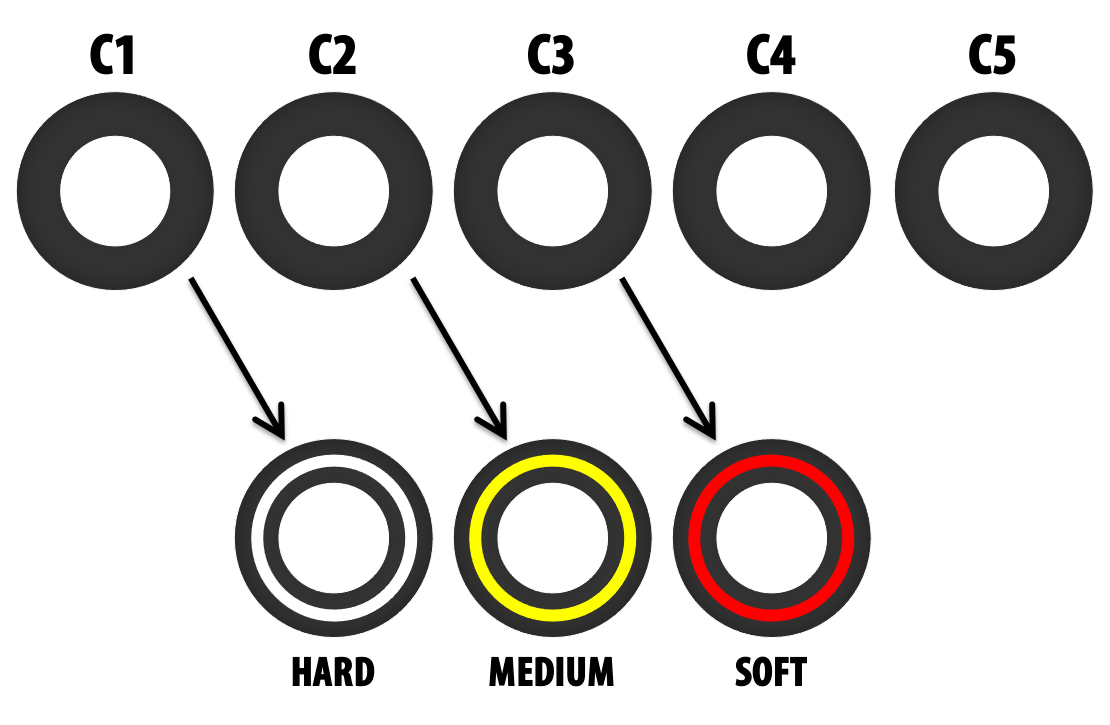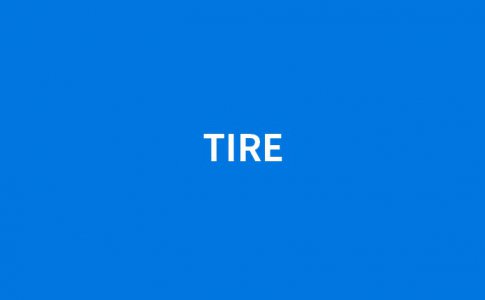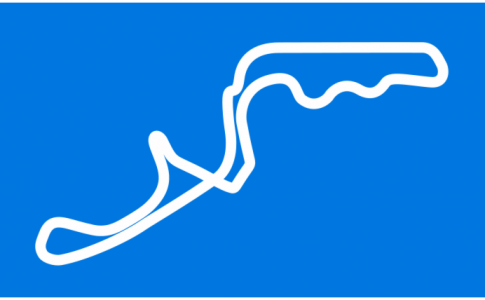2022年
2023年シーズンの内容については
こちらを参照ください。
現在のF1のタイヤはワンメイクと定められており、2022年シーズンのF1のタイヤは2021年シーズンに続いてイタリアの『ピレリ』が供給しています。
2022年シーズンからF1のタイヤのサイズがこれまでの13インチから18インチへ変更されます。ピレリはF1に先駆けてFIA F2で2020年シーズンから18インチのタイヤを導入していました。
また、2022年シーズンからF1マシンに装着されるホイールがワンメイクとなり、BBSがオフィシャルホイールサプライヤとして2024年まで全チーム共通のホイールを供給します。

ドライタイヤは5種類、レインタイヤは2種類
F1タイヤのコンパウンドは晴れ用の『ドライタイヤ』が5種類、雨用の『レインタイヤ』が2種類が設定されています。
各レースごとに5種類のドライタイヤの中から3種類が選択され、コンパウンドの硬い順に『ハード』、『ミディアム』、『ソフト』と呼ばれます。
レインタイヤは浅溝の『インターミディエイト』と深溝の『ウェット』の2種類があり、これらの3種類のドライタイヤと2種類のレインタイヤが各グランプリで供給されます。
このようにF1のタイヤは複数の種類がありますが、これらのタイヤを外見で識別できるようにタイヤのサイドウォールにペイントが施されています。
ドライタイヤ (5種類)
F1では2019年シーズンからピレリが供給するドライタイヤのコンパウンドが5種類となりました。
この5種類のコンパウンドは硬い順から、『C1、C2、C3、C4、C5』と呼びます。
ピレリはF1が開催されるサーキットの路面や気温などの特性を考慮し、この5種類の中から3種類のコンパウンドを事前に選択し各グランプリへ投入します。
各グランプリに投入される3種類のタイヤはコンパウンドが硬い順に『ハードタイヤ』、『ミディアムタイヤ』、『ソフトタイヤ』と呼びます。
ドライタイヤのサイドウォールはハードが白、ミディアムが黄色、ソフトが赤にペイントされ、どのコンパウンドのタイヤが装着されているのか外見で識別できるようになっています。
ハード タイヤ
(ホワイト)
ミディアム タイヤ
(イエロー)
ソフト タイヤ
(レッド)

一般的にタイヤは、柔らかいコンパウンドではグリップ力が高く、耐久性が低い特性を持っています。また、硬いコンパウンドではグリップ力が低く、耐久性が高い特性を持っています。
ただし、サーキット毎に異なる路面の状況や路面温度などとコンパウンドの相性があるため、常に柔らかいコンパウンドの方が速く走ることができるとは限りません。
各レースでどのコンパウンドが投入されるのかは、FIAとピレリによって事前に選択されます。
どのコンパウンドが選択されるのかについては、遅くともヨーロッパで開催されるレースにおいては9週間前、ヨーロッパ以外で開催されるレースにおいては15週間前に発表されます。
2022年 タイヤの仕様変更
2022年シーズンからピレリはこれまでの13インチタイヤに代わり、18インチタイヤをF1へ供給します。
タイヤのサイズが変更されるだけでなく、耐久性やコンパウンドなど2022年シーズンの新たなF1マシンのために開発されたタイヤへ変更されます。
2022年 各グランプリ供給タイヤ
| グランプリ | C1 | C2 | C3 | C4 | C5 |
| 第1戦 バーレーンGP | ● | ● | ● | ||
| 第2戦 サウジアラビアGP | ● | ● | ● | ||
| 第3戦 オーストラリアGP | ● | ● | ● | ||
| 第4戦 エミリア・ロマーニャGP | ● | ● | ● | ||
| 第5戦 マイアミGP | ● | ● | ● | ||
| 第6戦 スペインGP | ● | ● | ● | ||
| 第7戦 モナコGP | ● | ● | ● | ||
| 第8戦 アゼルバイジャンGP | ● | ● | ● | ||
| 第9戦 カナダGP | ● | ● | ● | ||
| 第10戦 イギリスGP | ● | ● | ● | ||
| 第11戦 オーストリアGP | ● | ● | ● | ||
| 第12戦 フランスGP | ● | ● | ● | ||
| 第13戦 ハンガリーGP | ● | ● | ● | ||
| 第14戦 ベルギーGP | ● | ● | ● | ||
| 第15戦 オランダGP | ● | ● | ● | ||
| 第16戦 イタリアGP | ● | ● | ● | ||
| 第17戦 シンガポールGP | ● | ● | ● | ||
| 第18戦 日本GP | ● | ● | ● | ||
| 第19戦 アメリカGP | ● | ● | ● | ||
| 第20戦 メキシコGP | ● | ● | ● | ||
| 第21戦 サンパウロGP | ● | ● | ● | ||
| 第22戦 アブダビGP | ● | ● | ● |
| グランプリ | C1 | C2 | C3 | C4 | C5 |
| 第1戦 バーレーンGP | ● | ● | ● | ||
| 第2戦 エミリア・ロマーニャGP | ● | ● | ● | ||
| 第3戦 ポルトガルGP | ● | ● | ● | ||
| 第4戦 スペインGP | ● | ● | ● | ||
| 第5戦 モナコGP | ● | ● | ● | ||
| 第6戦 アゼルバイジャンGP | ● | ● | ● | ||
| 第7戦 フランスGP | ● | ● | ● | ||
| 第8戦 シュタイアーマルクGP | ● | ● | ● | ||
| 第9戦 オーストリアGP | ● | ● | ● | ||
| 第10戦 イギリスGP | ● | ● | ● | ||
| 第11戦 ハンガリーGP | ● | ● | ● | ||
| 第12戦 ベルギーGP | ● | ● | ● | ||
| 第13戦 オランダGP | ● | ● | ● | ||
| 第14戦 イタリアGP | ● | ● | ● | ||
| 第15戦 ロシアGP | ● | ● | ● | ||
| 第16戦 トルコGP | ● | ● | ● | ||
| 第17戦 アメリカGP | ● | ● | ● | ||
| 第18戦 メキシコGP | ● | ● | ● | ||
| 第19戦 サンパウロGP | ● | ● | ● | ||
| 第20戦 カタールGP | ● | ● | ● | ||
| 第21戦 サウジアラビアGP | ● | ● | ● | ||
| 第22戦 アブダビGP | ● | ● | ● |
レインタイヤ (2種類)
F1では雨で濡れた路面を走行するためのレインタイヤは『インターミディエイト』と『ウェット』の2種類が設定されています。
ドライタイヤと同様にレインタイヤのサイドウォールにもペイントが施され、外見で識別できるようになっています。
インターミディエイトは緑、ウェットは青にペイントされています。
インターミディエイト タイヤ
(グリーン)
浅溝のインターミディエイトタイヤは、小雨のように雨量が少ない場合や雨があがりのように路面が乾いてきたような場合に使用されます。
ウェット タイヤ
(ブルー)
深溝のウェットタイヤは水はけ性能が高く、雨天時のタイヤとして使われます。
強い雨が降っている場合はウェットタイヤでも安定した走行が難しい場合があります。そのような場合は安全を考慮してレッドフラッグが振られ、セッションは一時中断となります。

各グランプリで供給されるタイヤセット数
F1では各グランプリにおいてドライバーごとに供給されるタイヤのセット数がレギュレーションで定められています。
2021年シーズンのF1では、供給されるドライタイヤのコンパウンドの内訳があらかじめ定められていましたが、2022年シーズンも継続されます。
スプリントの開催有無で供給されるドライタイヤのセット数とコンパウンドの内訳に違いがあります。
ドライタイヤ 13セット
(スプリント開催なし)
2022年シーズンのF1では、スプリントの開催が無い場合、供給されるドライタイヤは13セットと定められています。
13セットのうち、ドライでの決勝用のタイヤとして、ハードとミディアムが1セットずつ供給されます。路面がドライの状態で開催される決勝において、これら2セットのうち、どちらか1セットを必ず使用しなければなりません。
また、公式予選Q3専用のタイヤとしてソフトが1セット供給されます。
これら3セットのタイヤは使用義務のあるタイヤとして管理されます。
残りの10セットのドライタイヤのコンパウンドはハードが1セット、ミディアムが2セット、ソフトが7セットと定められています。
ハード
2セット
(ドライでの決勝用のタイヤ1セット含む)
ミディアム
3セット
(ドライでの決勝用のタイヤ1セット含む)
ソフト
8セット
(公式予選Q3用のタイヤ1セット含む)
ドライタイヤ 12セット
(スプリント開催あり)
スプリントの開催がある場合、供給されるドライタイヤは12セットと定められています。
スプリントの開催が無い場合と同様に、12セットのうち、ドライでの決勝用のタイヤとして、ハードとミディアムが1セットずつ、公式予選Q3用のタイヤとしてソフトが1セット供給されます。
これら3セットのタイヤは使用義務のあるタイヤとして管理されます。
残りの9セットのドライタイヤのコンパウンドはハードが1セット、ミディアムが3セット、ソフトが5セットと定められています。
ハード
2セット
(ドライでの決勝用のタイヤ1セット含む)
ミディアム
4セット
(ドライでの決勝用のタイヤ1セット含む)
ソフト
6セット
(公式予選Q3用のタイヤ1セット含む)
2021年シーズンのF1では、供給される13セットのドライタイヤのコンパウンドの内訳はハードが2セット、ミディアムが3セット、ソフトが8セットと定められていました。
このうち、ドライでの決勝用としてハードとミディアムが各1セットずつ、公式予選Q3用としてソフトが1セット供給されていました。
2019年シーズンのF1では供給される13セットのタイヤのうち使用義務の無い10セットのタイヤのコンパウンドを自由に選択することができました。
2022年シーズンのF1は2019年シーズンのように、使用義務の無いドライタイヤのコンパウンドの内訳を選択できるようになる可能性もありましたが、最終的に2021年シーズンと同様に、コンパウンドの内訳があらかじめ決められることになりました。
レインタイヤ 7セット
F1では雨用のレインタイヤは浅溝の『インターミディエイト』と深溝の『ウェット』の2種類が設定されいます。
レインタイヤはスプリントの開催有無に関わらず、各グランプリごとにインターミディエイトが4セット、ウェットが3セット供給されます。
インターミディエイト
4セット
ウェット
3セット
ドライタイヤの使用義務・タイヤの返却
ドライタイヤにはタイヤの使用義務と返却のルールがあります。
タイヤの返却は電子的に行われます。実際には次のセッションが始まるまでに各チームはタイヤメーカーのピレリに返却しなければなりません。
使用義務のあるタイヤ
(3セット)
ハード、ミディアムの各1セットはドライでの決勝で使用義務のあるタイヤとされ、どちらか1セットは決勝で必ず使用しなければなりません。
レース中にインターミディエイトタイヤもしくはレインタイヤを使用すればドライタイヤの使用義務は適用されません。
また、これら2セットのタイヤを決勝前に返却することは認められません。
ソフトタイヤの1セットは使用義務があるタイヤとされ公式予選Q3で使用しなければなりません。また、このタイヤを公式予選前に返却することは認められません。
このタイヤは公式予選Q3の参加に関わらず、公式予選終了から3時間30分以内に返却しなければなりません。
公式予選終了から3時間30分以内にソフトタイヤ1セットを返却
使用義務のないタイヤ
供給される13セットもしくは12セットのドライタイヤのうち、使用義務のある3セットのタイヤを除いたドライタイヤには返却の義務があります。
フリー走行1回目(FP1)、フリー走行2回目(FP2)、スプリントの終了後のタイミングで、以下のようにタイヤを返却しなければなりません。
FP1終了から2時間以内に1セットを返却
FP2終了から2時間以内に1セットを返却
(P2で最も周回数の多いタイヤ)
スプリント終了から2時間以内に1セットを返却
(スプリントで最も周回数の多いタイヤ)
ドライタイヤの追加供給
特定のグランプリでは、タイヤサプライヤからの要請に応じてFIAがタイヤ評価を目的として追加の仕様のタイヤを使用できるように認める場合があります。
この場合、フリー走行1回目とフリー走行2回目で使用できる2セットのタイヤが追加で供給されます。
これらのタイヤはフリー走行2回目終了から2時間以内に返却しなければなりません。
レインタイヤの使用義務・タイヤの返却
フリー走行ではレースコントロールから『ウェット宣言』が行われた場合に限り、雨用のインターミディエイトタイヤとウェットタイヤを使用することができます。

インターミディエイトタイヤの追加供給
金曜日に行われるフリー走行1回目とフリー走行2回目のどちらかでウェット宣言が行われ、インターミディエイトタイヤを使用したドライバーには、追加のインターミディエイトタイヤが1セット供給されます。
また、フリー走行1回目とフリー走行2回目でウェット宣言が行われていないものの、土曜日に行われるフリー走行3回目でウェット宣言が行われる可能性が高い場合もインターミディエイトタイヤが追加で1セット供給されます。
ただし、追加で供給されたインターミディエイトタイヤは公式予選が開始するまでに返却しなければなりません。
ウェットタイヤの使用義務
大雨の影響により、レースがセーフティカー先導でスタートする場合、ウェットタイヤを装着してレースをスタートしなければなりません。
また、セーフティカーが解除となるまでは、ウェットタイヤ以外のタイヤに交換することが禁止されます。
レーススタート時のタイヤ
2021年シーズンでは公式予選でQ3へ進出したドライバーは公式予選のQ2でベストタイムを記録したタイヤを装着してスタートしなければなりませんでした。
2022年シーズンにおいては、決勝のスタート時に装着しなければならないタイヤに関するルールが撤廃され、レーススタート時のタイヤを自由に選択できるようになります。
レース中のタイヤ交換義務
F1ではレース中に1回以上のタイヤ交換を行うことが義務付けられています。また、レース中に2種類以上のコンパウンドのタイヤを使用しなければなりません。
決勝用として供給されたハードタイヤもしくはミディアムタイヤのうち、どちらかのタイヤを使用する必要があります。
誤って、適切ではないセットのタイヤを装着してしまった場合は、すぐにピットインをして正しいタイヤへ交換しなければなりません。間違えたタイヤを装着したままコントロールラインを2回以上通過するとペナルティが科せられます。
レギュレーション
アーカイブ

























2022/3/15発行版
30) SUPPLY OF TYRES IN THE CHAMPIONSHIP AND TYRE LIMITATION DURING THE EVENT
30.1 Supply of tyres
a) The single tyre manufacturer (the appointed tyre supplier) appointed by the FIA must undertake to provide:
i) Three (3) specifications of dry-weather tyre at each Event, each of which must be visibly distinguishable from one another when a car is on the track.
ii) At certain Events one additional specification of dry-weather tyre may be made available to all Competitors for evaluation purposes following a recommendation to the FIA from the appointed tyre supplier. Competitors will be informed about such an additional specification at least one (1) week before the start of the relevant Event.
iii) One (1) specification of intermediate tyre at each Event.
iv) One (1) specification of wet-weather tyre at each Event.
30.2 Quantity, selection and specification of tyres during an Event
a) Except under Articles 30.1a)ii), 30.5e), 30.5f) and 30.5g):
i) At each Event where a sprint session is scheduled, each driver may use no more than twelve (12) sets of dry-weather tyres, four (4) sets of intermediate tyres and three (3) sets of wet-weather tyres during an Event.
ii) At all other Events, each driver may use no more than thirteen (13) sets of dry-weather tyres, four (4) sets of intermediate tyres and three (3) sets of wet-weather tyres during an Event.
b) A complete set of tyres will be deemed to comprise two (2) front and two (2) rear tyres all of which must be of the same specification and as allocated by the FIA, however, sets of the same specification may be mixed following the qualifying practice session.
c) Unless otherwise determined by the FIA and with the agreement of the appointed tyre supplier, no less than two (2) weeks prior to each Event, the FIA will provide all Competitors with the following information relevant to the Event in question:
i) Which tyre specifications will be made available by the appointed tyre supplier.
ii) The mandatory dry-weather race tyre specification(s) (up to two (2)).
iii) The mandatory dry-weather Q3 tyre specification (which will always be the softest of the three (3) specifications).
d) Unless otherwise determined by the FIA and with the agreement of the appointed tyre supplier, each Driver will be allocated the following specification of dry-weather tyres:
i) At each Event where a sprint session is scheduled:
• Two (2) sets of the hard specification of tyres.
• Four (4) sets of the medium specification of tyres.
• Six (6) sets of the soft specification of tyres.
ii) At all other Events:
• Two (2) sets of the hard specification of tyres.
• Three (3) sets of the medium specification of tyres.
• Eight (8) sets of the soft specification of tyres.
e) Once the above selections have been made the Technical Delegate will allocate sets of tyres to each driver from among the stock of tyres the appointed tyre supplier makes available for the Event.
30.3 Control of tyres
a) The outer sidewall of all tyres which are to be used at an Event must be marked with a unique identification.
b) Other than in cases of force majeure (accepted as such by the stewards), all tyres intended for use at an Event must be presented to the Technical Delegate for allocation prior to the start of the Event.
c) At any time during an Event, and at his absolute discretion, the Technical Delegate may select alternative tyres to be used by any Competitor or driver from among the stock of tyres the appointed tyre supplier has present at the Event.
d) A Competitor wishing to replace one unused tyre by another identical unused one must present both tyres to the Technical Delegate.
e) The use of tyres without appropriate identification may result in a race grid position penalty or disqualification from the sprint session or the race as appropriate.
30.4 Return of Tyres
a) The official return of tyres will be made electronically using the FIA Race Team Client. In the event of an issue with the system, and when instructed to do so by the FIA, each Competitor will be requested to provide the tyre return data in a CSV file format via email.
b) Any set of electronically returned tyres must also be physically returned to the appointed tyre supplier before the start of the following session.
30.5 Use of Tyres
a) All tyres must be operated in accordance with the prescriptions issued prior to each Event by the FIA and the appointed tyre supplier, including any additional or modified procedures set out in the Appendix to these Sporting Regulations or as communicated directly by the FIA and the appointed tyre supplier.
b) The only sets of tyres which may be used during an Event are those which are defined in Article 30.2a)i) and Article 30.2a)ii).
Any driver who uses a set of tyres of differing specifications or tyres not allocated to him during the sprint session or the race may not cross the Line on the track more than twice before returning to the pits and changing them for a set of tyres of the same specification. A penalty under Article 54.3d) will be imposed on any driver who does not change tyres as specified above. For the avoidance of doubt, a set of tyres of differing specifications will not be considered when assessing the number of specifications used during the race.
c) Tyres will only be deemed to have been used once the car’s timing transponder has shown that it has left the pit lane.
d) If an additional driver is used (see Articles 32.4, 32.5, 32.6 and 32.7) he must use the tyres allocated to the nominated driver he replaced.
e) If an additional specification of dry-weather tyre is made available in accordance with Article 30.1a)ii) two (2) sets of these tyres will be allocated to each driver for use during P1 and P2. Any such tyres must be electronically returned no later than two (2) hours after the end of P2.
f) At each Event where a sprint session is scheduled, if either P1 or the qualifying practice session are declared wet, one (1) additional set of intermediate tyres will be made available to any driver who used a set of intermediate tyres during either session. Under such circumstances, one (1) used set of intermediate tyres must be electronically returned before the start of the sprint session.
If neither P1 nor the qualifying practice session are declared wet, but the likelihood of P2 being declared wet is deemed by the FIA to be high, one (1) additional set of intermediate tyres will be made available to all drivers. Under such circumstances, one (1) set of intermediate tyres must be electronically returned before the start of the sprint session.
If intermediate or wet weather tyres are used during the sprint session, one (1) additional set of intermediate tyres will be made available to all drivers.
g) At each Event where a sprint session is not scheduled, if either P1 or P2 are declared wet one (1) additional set of intermediate tyres will be made available to any driver who used a set of intermediate tyres during either session. Under such circumstances, one (1) used set of intermediate tyres must be electronically returned before the start of the qualifying practice session.
If neither P1 nor P2 are declared wet, but the likelihood of P3 being declared wet is deemed by the FIA to be high, one (1) additional set of intermediate tyres will be made available to all drivers. Under such circumstances, one (1) set of intermediate tyres must be electronically returned before the start of the qualifying practice session.
h) From the twelve (12) sets of dry-weather tyres allocated to each driver under Article 30.2a)i):
i) One (1) set of the mandatory Q3 tyre specification may not be used nor returned before Q3. One (1) set of the mandatory Q3 tyre specification must be electronically returned no later than three and a half (3.5) hours after the end of Q3, even if they have not participated in Q3.
ii) Two (2) sets of the mandatory race specification(s) may not be returned before the race. For the avoidance of doubt, if there are two (2) mandatory race tyre specifications, one (1) set of each specification may not be returned before the race.
From the nine (9) remaining sets:
iii) One (1) set must be electronically returned no later than two (2) hours after the end of P1.
iv) One (1) additional set must be electronically returned no later than three and a half (3.5) hours after the end of Q3. This is in addition to the set referred to in Article 30.4h)i).
v) The mandatory Q3 tyre specification is the only dry tyre specification that is permitted to be used during the qualifying practice session.
vi) One (1) set with the highest number of laps in P2 must be electronically returned no later than two (2) hours after the end of P2.
vii) One (1) set with the highest number of laps must be electronically returned no later than two (2) hours after the end of the sprint session.
i) From the thirteen (13) sets of dry-weather tyres allocated to each driver under Article 30.2a)ii):
i) One (1) set of the mandatory Q3 tyre specification may not be used nor returned before Q3 and, for the cars that qualified for Q3, one set of the same specification must be electronically returned no later than three and a half (3.5) hours after the end of Q3.
ii) Two (2) sets of the mandatory race specification(s) may not be returned before the race. For the avoidance of doubt, if there are two (2) mandatory race tyre specifications, one (1) set of each specification may not be returned before the race.
From the ten (10) remaining sets:
iii) Two (2) sets must be electronically returned no later than two (2) hours after the end of P1.
iv) Two (2) further sets must be electronically returned no later than two hours after the end of P2 unless both P1 and P2 are either declared wet or cancelled, in which case one of these sets may be retained by each driver but must be electronically returned no later than two (2) hours after the end of P3.
v) Two (2) further sets must be electronically returned no later than two (2) hours after the end of P3.
j) Once all tyres have been returned electronically after the end of each day of on track activity the appointed tyre supplier will publish a list of the tyres which each driver has available to him for the remainder of the Event.
k) During any free practice session intermediate and wet-weather tyres may only be used after the track has been declared wet by the Race Director, following which intermediate, wet or dry-weather tyres may be used for the remainder of the session.
n) Unless he has used intermediate or wet-weather tyres during the race, each driver must use at least two different specifications of dry-weather tyres during the race, at least one of which must be a mandatory dry-weather race tyre specification as defined in Article 30.2c)ii). Unless a race is suspended and cannot be re-started, failure to comply with this requirement will result in the disqualification of the relevant driver from the race results.
If the race is suspended and cannot be re-started, thirty (30) seconds will be added to the elapsed time of any driver who was unable to use at least two (2) specifications of dry-weather tyre.
o) If the formation lap is started behind the safety car because of heavy rain (see Article 49), or the sprint session or race is resumed in accordance with Article 58.10a), the use of wet-weather tyres until the safety car returns to the pits is compulsory.
A penalty under Article 54.3d) will be imposed on any driver who does not use wet weather tyres whilst the safety car is on the track at such times.
30.6 Testing of tyres.
a) From the time at which each Competitor receives fitted tyres from the appointed tyre supplier at or before an Event these may not be used on any rig, simulator or vehicle, other than the Formula One car for which they were intended.
b) Tyres supplied to any Competitor at any time may not be used on any rig or vehicle (other than an Formula One car on an FIA Grade 1 or FIA Grade 1T Circuit, at the exclusion of any kind of road simulator), either Competitor owned or rented, providing measurements of forces and/or moments produced by a rotating full size Formula One tyre, other than uniquely vertical forces, tyre rolling resistance and aerodynamic drag.
c) Tyres may be used on a test rig providing forces control and monitoring by Formula One rim manufacturers for the sole purpose of proof testing their products.